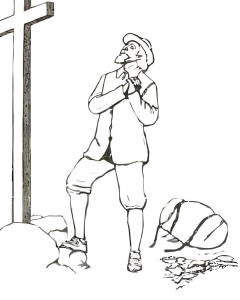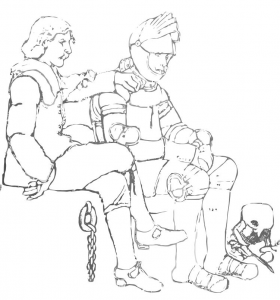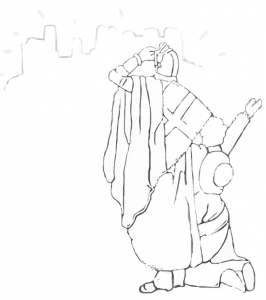Today’s post is the third part in a series based on my recent talk on shepherding children through their life-long literary journey. You can read part one here (which includes instructions for how to host a Pilgrim’s Progress party), part two here, and below is the final installment. You can also check out our Pilgrim’s Progress shop for a devotional guide to go along with a great picture book version of the story.
Enchanted Ground


1) Secular, mainstream publishers and authors offer books that are often visually striking and informative (especially picture books), entertaining, and in many cases, involve authors, illustrators, and researchers who are a) more talented than their Christian counterparts or b) may even be Christians in disguise. I have met a number of Christian authors who are published with major publishers and have never been promoted as such. On the other hand, these Christians often have to fit within a non-Christian framework. In other words, so long as they don’t contradict the most treasured beliefs of mainstream culture, they are welcome.
I should probably take just a minute and explain what that framework looks like. If your kids go on to study deep in the humanities or if they minister to those in the arts, this is the dominant narrative: a hundred years or so ago, we were a repressive culture. But since then, courageous men and women have been breaking down barriers, earning new rights for women, black people and other races, the poor, children, non-Christians and increasingly, sexual deviants. This isn’t all bad. Christians have at times benefited from (and been part of!) the cultural push for breaking barriers (i.e. William Wilberforce). But our culture has no framework of morality to replace the bad rules once they are knocked down, so it is ultimately destructive and leaves you empty. (See my autobiography, Behind the Bookcase for more on this.)
What does this look like in books for kids? Award-winners and especially non-fiction books almost always reinforce this narrative, and it can look innocuous or quite offensive. See for instance the desire to rewrite the Thanksgiving story in ways that glorify Native Americans and demonize the Pilgrims. In more mainstream YA novels, it means books that transgress taboos into increasingly darker, more violent and sexually explicit content while winning a moral stamp of approval from the book world. (See Sherman Alexie’s article on why the best kids’ books are written in blood.) And unlike movies, there is no independent ratings board to help parents know the content of books. (Redeemedreader tries to help on this front!)
I won’t get into a detailed discussion of the solution, but let’s just say I see it as Christ. We need His law, His rules for life, as well as His death covering the many ways we don’t live up to that law. The solution isn’t to kill the standard (we’ve already done that 2,000 years ago), but to die to ourselves and live in Him.


3) Libraries: Libraries are locally organized, so they differ around the country. But you need to be aware that the library sciences are dominated by people who embrace a creed of tolerance that hypocritically promotes certain values (i.e. anti-Nazi ideas as well as pro-homosexual ones) while claiming neutrality. Ernest Istook, a law-maker who helped write the Child Internet Protection Act, wrote this year that 1/3 of American public libraries have chosen not to accept public funds so that they can continue not filtering—and by default providing—pornography to their patrons. Libraries that try to create any kind of standard about sexually explicit material may be hunted by the ALA (American Library Association) and its connections with the ACLU, not to mention major bookseller, author, and anti-censorship organizations.
4) Images and ereaders: Kids books, like the rest of our culture, are moving toward more images and less text. The problem here is when image-based storytelling begins to erode our ability to think and communicate in words, which is how God has revealed Himself. In terms of the gospel, a Christmas picture of a baby isn’t enough; we have to know his name is Jesus. Christians are going to have to work hard to resist this cultural tide, to choose books instead of only movies, paper books over only ereaders (which often turn books into video games), and not to let boys linger in graphic novels instead of progressing into written-word novels. None of these alternatives are bad in and of themselves—movies, ereaders, or graphic novels—but in the context of our cultural drift, they can be very damaging.
Celestial City
Raising redeemed readers in this culture is getting harder. But as the culture grows darker, His light will only shine that much brighter.
Further Resources
Break Point Youth Reads: https://www.breakpoint.org/features-columns/youth-reads
Pluggedin.com: https://www.pluggedin.com/
World Magazine book and movie reviews: https://www.worldmag.com
Redeemedreaeder.com
Pilgrim’s Progress devotional (free): https://redeemedreader.com/pilgrims-progress-shop
Facebook Page: https://www.facebook.com/redeemedreader
How to Help: 1) Sign up on our homepage (www.redeemedreader.com) for a free biweekly newsletter to keep up with new resources! 2) read and recommend to your friends! 3) click through our ads to Amazon.com and when you buy anything from their site, we get a small kickback, and 4) leave comments! 5) invite Janie and I to speak at your events.
I thought I’d put up a few pictures from this event later in the week. Would love to hear your comments!
Stay Up to Date!
Get the information you need to make wise choices about books for your children and teens.
Our weekly newsletter includes our latest reviews, related links from around the web, a featured book list, book trivia, and more. We never sell your information. You may unsubscribe at any time.
Support our writers and help keep Redeemed Reader ad-free by joining the Redeemed Reader Fellowship.
Stay Up to Date!
Get the information you need to make wise choices about books for your children and teens.
Our weekly newsletter includes our latest reviews, related links from around the web, a featured book list, book trivia, and more. We never sell your information. You may unsubscribe at any time.
FREE Bible Guide!
Get a guide to the Best Bibles for Children and Teens. Perfect for an Easter gift.
We'd love to hear from you!
Our comments are now limited to our members (both Silver and Golden Key). Members, you just need to log in with your normal log-in credentials!
Not a member yet? You can join the Silver Key ($2.99/month) for a free 2-week trial. Cancel at any time. Find out more about membership here.
3 Comments
Leave a Comment
You must be logged in to post a comment.



Another resource can be found here:
https://www.geneva.edu/object/nr_pilgrims_progress_windows_8-11.html
This is a book published by Geneva College. The McCartney Library at Geneva has gorgeous stained glass windows, created by Henry Willet of Philadelphia, depicting Pilgrim’s Progress. Worth the trip to Beaver Falls, PA to view!
Very cool! Thanks, Kae.
Thanks for this series, Emily. As one who has accompanied you on this journey, I suspect our philosophy is not always clear, especially for new readers. It’s good to see a concise statement like this.